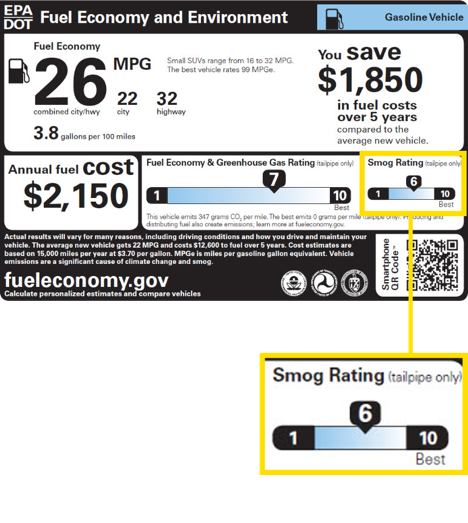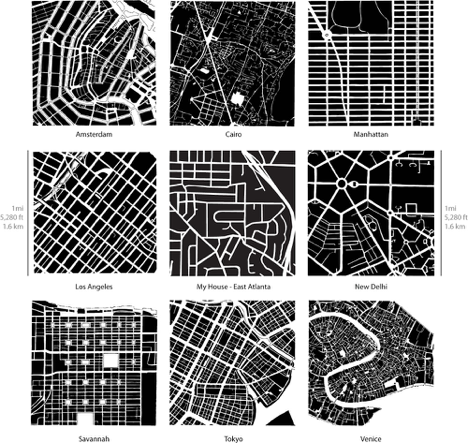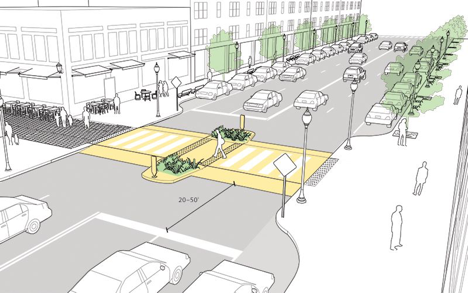Create a connected, complete, and safe bicycle and pedestrian system; emphasize navigational simplicity and connecting key neighborhoods, destinations, and transit.
One of the most important reasons commuters do not use active transportation to get to work or school is because they feel it is unsafe, and the sidewalk and bike lane networks are not continuous or well-maintained. It is important to develop complete alternative transportation networks in order for them to be useful and used by commuters.
Tool: Adopt a “Complete Streets” approach and philosophy that all streets and development on streets be designed and operated to enable safe access for all users, ages, and abilities.
Complete streets policies direct transportation planners and engineers to consistently design streets with all users in mind (drivers, transit riders, pedestrians, bicyclists, the elderly, children, and people with disabilities). Many jurisdictions around the country have adopted Complete Streets policies and national model policies can be used as a starting point. A Complete Streets policy is one effective way to institutionalize the goals of this plan within the City.
Resources
Case Study
Tool: Develop bicycle parking requirements including long-term bike parking.
Convenient and secure bicycle parking—including bike racks, bike lockers, and covered bike parking—is essential to making bicycling a legitimate and viable transportation options. If Provo residents know that, no matter where they’re going, they will be able to find a secure place to lock their bicycles, they would able to consider bicycling as a transportation option. Thorough bicycle parking requirements account for both short-term and long-term parking, promote proper siting and layout, and allow for conversion of vehicular parking to bicycle parking.
Resource
Case Studies
Tool: Require or provide end of trip facilities (such as changing rooms or showers) for bicyclists and pedestrians in dense employment areas.
Commuters who bicycle or walk to work can often arrive wet, muddy or sweaty. In order to make walking or cycling to work viable for many employees, showers and changing facilities (either on-site or close to work) are a necessary amenity.
Resources
Case Study
- Indy Bike Hub, Indianapolis. The Indy Bike Hub is a partnership between the City of Indianapolis, the YMCA, and Bicycle Garage Indy (a local bike shop). Situated on the Indianapolis Cultural Trail, the Bike Hub provides an ideal location for downtown employees to shower, change and store their bicycles. Other amenities such as a full service bike shop and exercise gym are also present on-site.
http://indybikehub.org/
Tool: Establish a connectivity retrofit plan for existing developments in order to improve pedestrian and bicycle access.
Creating route connections can provide access to many parts of the pedestrian system that would otherwise not be linked. Creating direct routes promotes biking and walking while decreasing vehicle emissions by shortening trip lengths.
Case Study
Tool: Require a physical separation between the sidewalk and street such as park strip, on-street parking or paved tree grate area.
Streetscape requirements that provide physical separation between pedestrian, cyclists and automobiles, create a safer, more walkable environment. Street trees provide shade and separation from automobiles and help to calm traffic. On-street parking and parked cars provide a buffer for cyclists and pedestrians.
Resource
Tool: Coordinate connectivity of trails, bikeways and pedestrian facilities.
Connectivity is a key to making biking and walking convenient. Connectivity standards should include coordination among different city departments to encourage connectivity between destinations. New development or redevelopment should require designated bikeways. Street networks should be designed to ensure connectivity for pedestrians and cyclists.
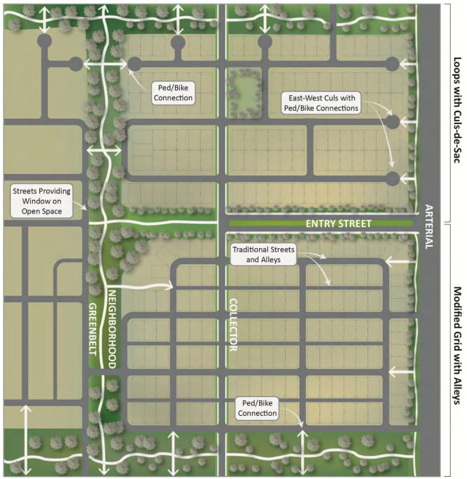
[v]
Tool: Maintain an up-to-date bicycle and pedestrian master plan to coordinate connectivity of trails, bikeways and pedestrian facilities.
Maintaining an up-to-date master plan helps to ensure pedestrian friendly policies and design within future development. Updating the City’s master plan allows them to build on past successes while developing a future guide for new visions and policies. Provo currently has a Bicycle Master Plan which was adopted in September of 2013. The City should also consider developing a Pedestrian Master Plan to complement the existing Bicycle Master Plan.
Resources
Tool: Provide lighting along streets, trails and public spaces to ensure, walking, biking, or other active transportation options are safe.
The use of appropriate lighting along sidewalks, crosswalks and public spaces creates a safer and more comfortable environment for cyclists and pedestrians. Pedestrian scale lighting promotes safety through traffic calming and illuminated bikeways while discouraging criminal activity. People are encouraged to bike and walk more when they feel safe, especially at night. Lighting requirements should also minimize light pollution.
Resource
Tool: Require pedestrian connectivity through the end of cul-de-sacs.
Cul-de-sacs often force people to take long, indirect routes to their destinations because there is no direct access through the end of a cul-de-sac. For example, if a cul-de-sac is adjacent to a school or park, children in the cul-de-sac may live just a few hundred yards from the school or park. But rather than walking to these destinations, they are driven half a mile in a car because their street is a dead-end with no through-way. They have to take a winding, often busier, route to reach their destinations.
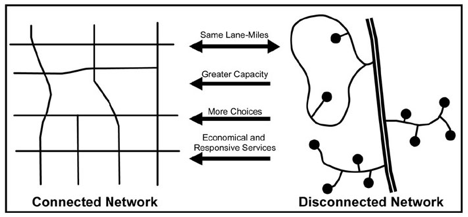
[vi]
Case Study
- Cul-de-sac connections, California. Davis, California, requires that cul-de-sacs connect bicycle/pedestrian corridors. “Davis streets shall be connected with multiple route options for bike and pedestrian travel in new and developed areas. Cul-de-sacs are allowed provided they connect to bicycle/pedestrian corridors.” (from the Davis General Plan) http://cityofdavis.org/home/showdocument?id=4809
Tool: Post signs stating the distance and pointing in the direction of multiple popular destinations.
Street signage can provide the same navigational infrastructure for pedestrians and bicyclists as freeway signage does for vehicle traffic. Abundant, clear signage would not only encourage people to use active transportation by facilitating pathway finding, but also makes visitors more comfortable, makes foot and bike traffic feel as important as vehicular traffic.




